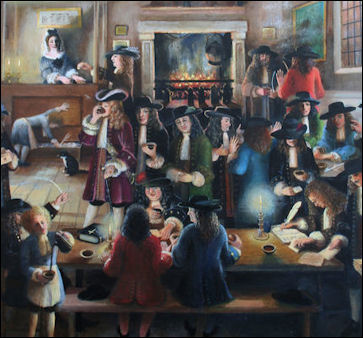CHOCOLATE
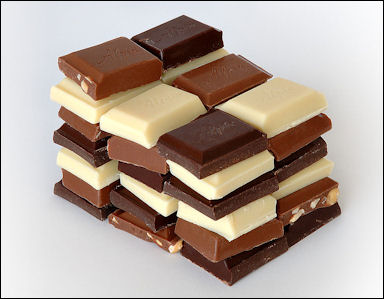
Chocolate Chocolate is made from cocoa, a processed powder made from the pod of the cacao plant, which has nothing to with the coca plant, the source of cocaine, or coconuts. The best chocolate comes from top-quality cacao beans, grow in a number of places around the world and vary as much as coffee beans.[Sources: Bill Buford, The New Yorker, October 29, 2007; Patricia Gadsby, Discover, August 2002; Corby Kummer, Atlantic magazine, October 1995; Gordon Young, National Geographic November 1984 ╗ ; Ruth Mehrtens Galvin, Smithsonian]
The English language uses the word “cacao”, the Mayan word for the tree, and “cocoa,” an 18th century corruption interchangeably. Cacao is produced mainly in tropical areas, but chocolate is consumed mostly in temperate regions, particularly the United States, Europe, Russia and Japan. Although Africa produces most of the world’s cacao Africans eat very little chocolate, in part, because chocolate melts in hot weather. Most chocolate is consumed in the form of candy. This is a relatively new idea. During most of its existence it was consumed as a drink.
The 19th century culinary genius Jean Anthelme Brillat-Savarin once declared: “Nine out of ten person say they love chocolate, the tenth lies.” Frederick Schilling, founder of Dagoba organic chocolate, told The New Yorker. “What do I want from a chocolate? A beginning and an end. I start with the breast of woman on her back. That’s my flavor curve. You start with the belly...You then move up her body, climbing slowly, rising up the flattened curve to the breast, gentle, and the nipple pops out suddenly. Have you ever noticed how a woman’s nipple pops out when she’s on her back? Then you slide down, an elegant finish...It always comes back to sex.”
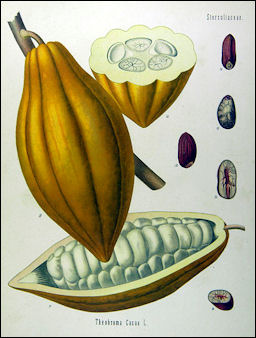
cacao fruit Chocolate has more that 1,200 distinct flavor components (by contrast strawberries have only 400) and is nearly impossible to artificially mimic. Producing good quality chocolate has been compared with producing good wines: both rely on taming different varieties of beans or grapes, and soil and weather are key to creating good flavors. The cacao plant was named “ Theobroma cacao” ("food of the gods") in 1753 by the Swedish botanist Linnaeus.
Books: “Chocolate: History. Culture and Heritage” edited by Louis Evan Grivetti and Howard-Yana Shapiro (Wiley, 2009); “ True History of Chocolate” by Sophie and Michael Coe, food historians (Thames & Hudson); “ Chocolate: A Bittersweet Saga of Dark and Light” by Mort Rosenblum (North Point Press)
Websites and Resources: All About Chocolate fieldmuseum.org ; Encyclopedia of Life Cacao Plant eol.org/pages/484592 ; Chocolate and the Maya authenticmaya.com ; Chocolate Food of the Gods site exhibits.mannlib.cornell.edu/chocolate ; Cacao Tree hort.purdue.edu/newcrop/duke_energy/Theobroma_cacao ; International Cocoa Organization (ICCO): www.icco.org/ ; Wikipedia article Wikipedia ; Food of the Gods e-book gutenberg.org/ebooks ; Cadbury Chocolate: cadbury.co.uk ; Hersey making Chocolate hersheys.com/discover/ ; Production of Chocolate sfu.ca/geog
Origin of Chocolate
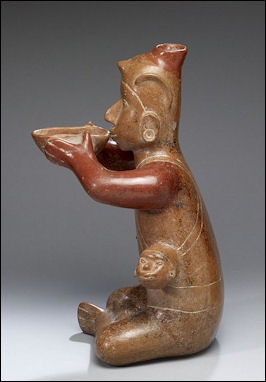
Seated Male with Trophy Heads
and Cup (perhaps for cacao drink)
from Colima Cacao beans come from a rain forest plant that hails from the lower Amazon basin, where Indians know the plants mostly as a source of a pulpy fruit with a lemony taste and has a pearlike texture. Genetic research indicates some these South American plants made their way to what is now southern Mexico, Guatemala, and Belize where they were cultivated by native people living there. It is not known why people started consuming the beans because they have a very bitter flavor.
Early Americans began consuming early forms of chocolate at least as early as the 12th century B.C. In 2007, residue from fermented cacao pulp was found in a chocolate pot dated to 1150 B.C. that was unearthed in Honduras. The residue appears to have come from an alcoholic drink that archeologists involved with the discovery have theorized may have been used to celebrate new births and weddings. The discovery was made by team led by John Henderson, a professor of anthropology at Cornell. The team found traces of theobromine, a chemical found only in the cacao plant, on elegant pottery, thought to be used in ceremonial occasions, unearthed at the Puerto Escondido site in the Ulua Valley of Honduras.
Henderson reported his finding in the Proceedings of the National Academy of Sciences. He has theorized that chocolate was discovered by early Americans trying to brew a kind of beer later called “chicha” by the Spanish. Theobromine was found in 11 of 13 vessels examined, the vessels were designed for pouring and drinking and resemble vessels used later in Mesoamerica for marriage and birth ceremonies. Henderson told the New York Times, “Cacao was the social grease of Mesoamerica.”
Early History of Chocolate

Maya nobleman offering cocoa paste The Olmec, who established a civilization in the Gulf Coast of Mexico around 1300 B.C., drank cacao. They called their drink “kakawa”. Semi-wild trees can still be found in the humid lowlands they inhabited.
The Mayas drank concoctions made of sweetened chocolate and water and had a glyph for cacao. They had a god of chocolate and used cacao as a currency. Studies of pots used to make chocolate by the Mayans indicate that liquid chocolate was brewed into a froth to produce foam, which the Mayans considered the most delicious part of the drink. The foam was created by using spouts, through which a chief would blow air as the drink was poured from one vessel to another.
Cacao was believed to have been brought to earth by the great god Quetzalcoatl, who promised mankind an endless supply of the stuff in the afterlife. Only nobleman and trusted soldiers were allowed to drink it. The Toltecs staged rituals for “ xocoatl” (meaning "bitter water" or "chocolate") in which chocolate-colored dogs were sacrificed. Itza human sacrifice victims were sometimes give a cup of chocolate before their execution.
Book:” True History of Chocolate” by Sophie and Michael Coe is said to have the best account of chocolate in New World.
Chocolate and the Aztecs
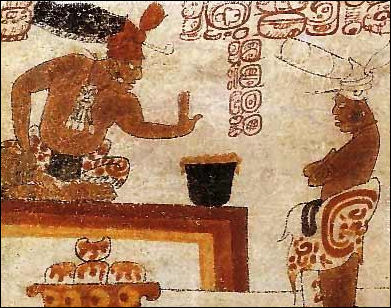
Mayans and cacao Like the Mayans, the Aztecs used cacao beans as currency. One Spanish chronicler wrote they were used to acquire “gold, slaves, clothing, things to eat, everything.” Three beans bought a fresh avocado; one bean, an overripe one. Ten beans could buy a rabbit. A hundred beans, it was said, was enough to buy a slave. The beans were mixed with water corn and spices to make an aphrodisiac served at aristocratic weddings. The crushed beans were used to cure dysentery.
The beans were stored in large warehouses. A total of 960 million beans were stored in one warehouse according to Sophie and Michael Coe in the” True History of Chocolate”. The Aztec were unable to grow cacao in the relatively dry climate of their homeland and relied on rainforest farmers to produce it.
Delivered from the Garden of Life in the Aztec creation myth, chocolate was a luxury item enjoyed exclusively by the elite and was an offering to the gods. It was used in the worship of the fertility goddess Xochiquetzal and was consumed at births, sacrifices and funerals. Rituals often involved women, suggesting an erotic element to the drink.
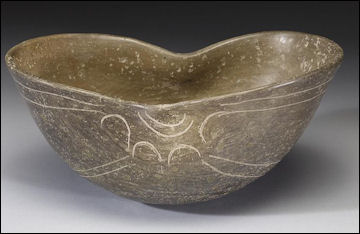
Olmec bowl with incised motifs Montezuma, the Aztec emperor, was particularly fond of chocolate served with snow brought down from the mountains. He often drank an extra cup before visiting his harem. He wouldn't let his women drink it though out fear that they would become too aroused.
Montezuma's court drank an estimated 2,000 pitchers of chocolate drink a day. They drank it flavored with maize, vanilla beans (which also originated from the New World), chili pepper, pimentos and other spices. The drink was so special it could only de served once in golden goblet which was discarded after one use.
Cortes witnessed an elaborate form of chocolate drinking when he arrived in Tenochtitlan (Mexico City) in 1519. The seeds, or “beans” as they were called, were roasted over a fire and crushed into a paste. Even though the drink, called “cacahuatl”, was flavored with flowers, maize, honey, chilies and vanilla, and diluted with cold water, it was still quite bitter. It was poured between vessels until a froth formed and served in a lacquered gourd by a procession of holy women, to Motecuhzoma Xocoyotzin, who is said to have once stayed up all night drinking 50 cups of “cacahuatl” in one sitting.
Chocolate Arrive in Spain
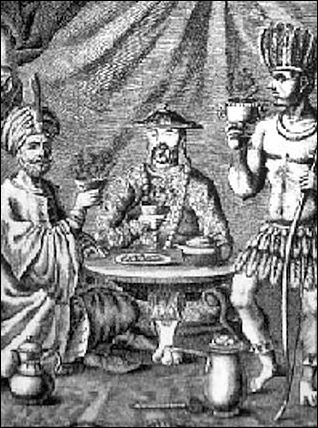
chocolate in Spain in the 17th century Chocolate was first seen by Europeans on the Caribbean island of Valrhona (now the name of a French chocolate company). In 1502, in his last voyage Columbus came across some Mayans carrying brown cacao beans in a dugout canoe on the island near Yucatan peninsula. It was noted that the beans were so precious that everyone panicked when some spilled. But otherwise Columbus was anxious to continue on with his voyage and dismissed the beans as almonds.
Columbus collected a few beans and brought them back to Spain. No one knew what to do with them until Cortes met Montezuma and observed him drinking cup after cup of “ xocoatl” . Cortes took the beans to Haiti and Trinidad and introduced them to Africa where he established that continent's first "money plantations." In Chiapas, a bishop, worried about the corrupting affect of cacao on young women, banned the drink.
The first chocolate drink consumed in Europe was drunk by Prince Philip, the future king of Spain, in 1544. Made from roasted and ground cacao beans, water, wine and peppers, it was presented to him by a Dominican priest and made by a group of rainforest farmers from Guatemala named the Kekchi Mayans. The first commercial shipment arrived in Seville in 1585.
Spaniards went bonkers over chocolate, consuming it with a passion usually associated with a drug. Charles V reportedly decided to add sugar to chocolate and that became almost an instant hit. Chocolate and sugar arrived in Europe around the same time before tea or coffee.
The chocolate drink made by Spanish in the early 1600s was served warm rather than cold as the Aztecs drank it. The Spanish were the first to mix it with sugar. They also added cinnamon and nutmeg and other spices popular in Europe at the time. The Spanish had their own drinking ritual, using ornate serving vessels and a special stirrer called a” molinillo” to stir the drink into a froth. The beans most unlikely came from Guatemala and were the blonde-brown “criollo” variety valued today. “Criollo” means “native” in Spanish.
Spanish Monopoly on Chocolate

Chocolate pot The recipe for chocolate remained a secret of Spanish monks and noblemen for almost a century, until 1615 when a 14-year-old daughter of Philip III married Louis XIII of France and the tasty treat was introduced to the French court. From there it spread across Europe and was widely embraced. Casanova liked it; monks were tempted to break their fast with. At one time there were nearly 2,000 chocolate cafes in London alone. Brillat-Savarin wrote, the “ladies...are madly addicted to chocolate, to such a point that, not content to drink it several times each day, they even have it served to them in church."
To meet the demand in Europe, Spaniards planted cacao in much of South and Central America in the 18th century. Thousands of slaves were put to work on cacao and sugar plantations. After blights and diseases ruined crops in the Americas and the Caribbean, cacao was brought to the Dutch East Indies in 1778 and Africa in 1822, where plantation were established in Cameroon, Nigeria and the Gold Coast.
Chocolate was an important trade item for Jews who traveled to the New World to escape persecution in Spain in the 16th and 17th centuries. They are thought to have brought chocolate to Amsterdam and perhaps to France.
Chocolate in Europe
The first chocolate shop opened in London in 1657. Two famous British private clubs, White’s and the Garrick, got their start as chocolate houses, Among those who were fond of the drink were chronicler Samuel Pepys. He wrote in 1664: "To Mr. Blands and there drank my morning draft in good Chocolatte, and...sent home for another.” Early consumers knew little about what they were drinking other than it came from the New World.
European coffee and chocolate house When the drink became so popular and not enough supplies could be secured fortune seekers planted new trees and scoured the globe looking for new varieties. The Spanish found a darker, more bitter variety in Venezuela and Ecuador related to the original chocolate beans from the Amazon basin. They called their find “foratero” . They planted trees in Trinidad. The French planted some in Martinique, the English in Jamaica. Jesuits discovered the original “foratero” deep in the Amazon. They tried to harvest it but their crop often rotted before reaching port.
Development of Chocolate
The Swiss were the ones who figured out that cocoa beans could be roasted, ground and melted into hunks of chocolate. In 1819, a 23-year-old Swiss man, François-Louis Caller, began manufacturing chocolate blocks on a large scale. Later Italians and French began making chocolate in sheets. In the mid-19th century the Cadbury brothers, in England, made the first chocolate bar. By 1850 chocolate was being made in factories on a large scale.
“Dutching” was invented in 1828 by the Dutch chemist Coenraad van Houten, who was trying to work out a way to make a chocolate drink that didn’t come out grainy because the fats didn’t mix with water. He squeezed out the fats with a heavy press and pulverized the left over dry material into a powder. He then added an alkaline, sodium carbonate. The result: smooth modern cocoa. What van Houten did press a pale substance called cocoa butter (chocolate fat) out of the cacao bean. Two decades later sugar, coca butter and cacao powder were mixed, and "eating chocolate" became all the rage.

The Chocolate Girl by Jean-Etienne Liotard In 1867, in Vevey on Lake Geneva, Nestle was trying to create a baby formula that wouldn’t spoil. He placed milk in a sealed container, sucked out the air with a crude pump, and heated it until the water in the milk evaporated. In a vacuum, milk boils at a lower temperature and doesn’t curdle. In 1876, Daniel Peter, the town’ chocolateer, gave some of the formula to his newborn child and realized its implication: powdered milk could be mixed with cacao without forming a lumpy mess. The discovery not only made chocolate sweeter and less bitter as the chocolate was diluted with milk and sweetened with more sugar it made it cheaper because milk was the main ingredient. In 1883, Peter’s Chocolate won a Gold Medal at an Amsterdam Exhibition. In 1891 he began selling his product in the United States.
In the 1870s and 1880s Rodolphe Lindt, added cocoa butter to milk chocolate to smooth the texture and the invented, a shell-shaped machine that churned and turned the chocolate mixture for three days to make it even smoother. The original conche is still in use gently stirring the chocolate to give it a smooth texture. Nestlé and Lindt are now two of the biggest chocolate manufacturers in the world. see Switzerland
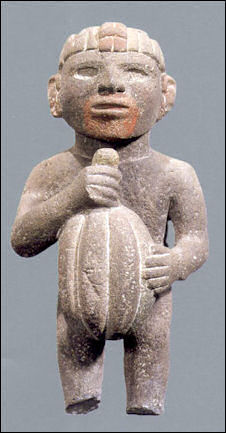
Aztec sculpture of cacao Most Americans knew little about chocolate in 1893, when a German company displayed chocolate-making equipment a the Chicago World’s Fair. Among those who bought every piece of equipment there was Milton Hershey, who went on to establish a famous chocolate company. Hershey had tried for years to make milk chocolate but couldn’t get it right: his milk kept curdling. Finally he settled for milk chocolate that was slightly soured. Even today, because of this, many Europeans are turned off by the taste of American chocolate.
Chocolate and Health
The Aztecs drank chocolate for medicinal purposes such as calming agitation, improving digestion and gaining weight. In the 17th century it was touted as an aphrodisiac. The health benefits of chocolate were first described in detail by Andrew Waterhouse in a study published in “The Lancet” in 1996.
Chocolate is also a high energy food. Sir Edmund Hillary devoured pounds of it climbing Everest and Apollo Space crews took it to the moon. Dark chocolate contains vegetable fats rather than milk fats. Contrary to popular myth there is no evidence that chocolate causes acne or tooth problems, and there may even be a substance is cocoa powder that inhibits tooth decay.╗
A study by Beatrice Golomb of the University of California, San Diego found that people suffering from depression eat more chocolate than other people and the amount they eat increases with the severity of their disease.
According to a Dutch study released in 2006, men who consume a lot of cocoa had a 50 percent lower risk of dying of disease than those who didn’t. The study credited the benefits to antioxidants and flavanols found in cocoa, which boost the functioning of cells that line the blood vessels, lessening the risks from cholesterol and other chemicals that can cause heart attacks, cancer and lung illnesses.
Chocolate and Antioxidants
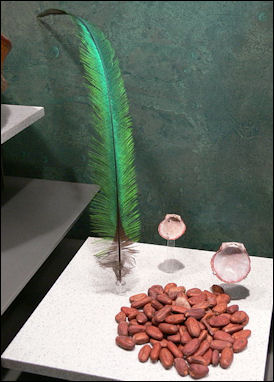
chocolate stuff owned
by the composer Handel Raw cacao beans are very high in antioxidants, chemicals found in red wine, fruits and vegetables and tea counter that the effects of free radicals, unstable atoms that attack human cells and tissues and have been linked to ageing and a range of ailments, including Parkinson’s disease, cancer and heart disease. However when cacao beans are processed alkaline is added, destroying many of the antioxidants according to chocolate maker Frederick Schilling.
Chocolate nevertheless still large amounts of polyphenols, cancer-fighting antioxidants. A cup of hot cocoa contains five times as many polyphenols as black tea, three times as many as green tea and twice as many as red wine. A fifty gram bar of dark chocolate contains more than four times the polyphenols than a bottle of red wine.The problem with polyphenols is that are also linked with bitter flavor. In some cases high-grade chocolates are low in polyphenols while low-grade chocolates are high in them.
There is evidence that cocoa lower blood pressure, improves blood flow and inhibits the formation of blood clots. Polyphenols are credited with having a positive effect on the heart and circulatory system. A study by Greek scientist showed that eating dark chocolate improved blood flow by helping blood vessels to dilate, reducing the chance of blood clots from forming. Antioxidant flavonoids in 100 grams dark chocolate to improve blood flow in healthy young adults for three hours. The jury is still out as whether it chocolate reduces heart disease since chocolate products often contain ingredients that are high in fat, sugar and calories.
Chocolate Buzz
Cacao contains more than 500 chemical compounds, many of them linked to defending the plants seeds from fungi, bacteria and viruses in the wild. Among them are serotonin, a neurotransmitter associated with well-being; a cannabinoid similar to what is found in marijuana; and a nueromodulator, phenyethylamine, an amphetamine-like anti-depressant.
“Phenylethylamine” is naturally produced in the brain and is said to increase when people fall in love. It also contains compound similar to natural receptors in the brain that interact with THC, the active ingredient of marijuana. It is estimated that if a person eats 25 pounds of chocolate he will get the same buzz as one joint of marijuana.
Chocolate contains alkalies, the mild stimulant theobromine, small amounts of caffeine. Some people claim the theobromine in chocolate gives them a buzz. Studies of the substance show that it causes people to urinate. It sometimes sends dogs into cardiac arrest although nothing like that has ever been reported with humans.
Most chocolate bars contain caffeine. A Hershey milk chocolate almond bar contains 25 milligrams of caffeine, compared to 200 in a 12-ounce cup of brewed coffee. Dark chocolate contains three times as much as caffeine as milk chocolate but you’d have to eat half a pound of it to get the same caffeine as the 12-ounce cup of coffee.
Image Sources: Wikimedia Commons
Text Sources: National Geographic, New York Times, Washington Post, Los Angeles Times, Smithsonian magazine, Natural History magazine, Discover magazine, Times of London, The New Yorker, Time, Newsweek, Reuters, AP, AFP, Lonely Planet Guides, Compton’s Encyclopedia and various books and other publications.
Last updated March 2011

